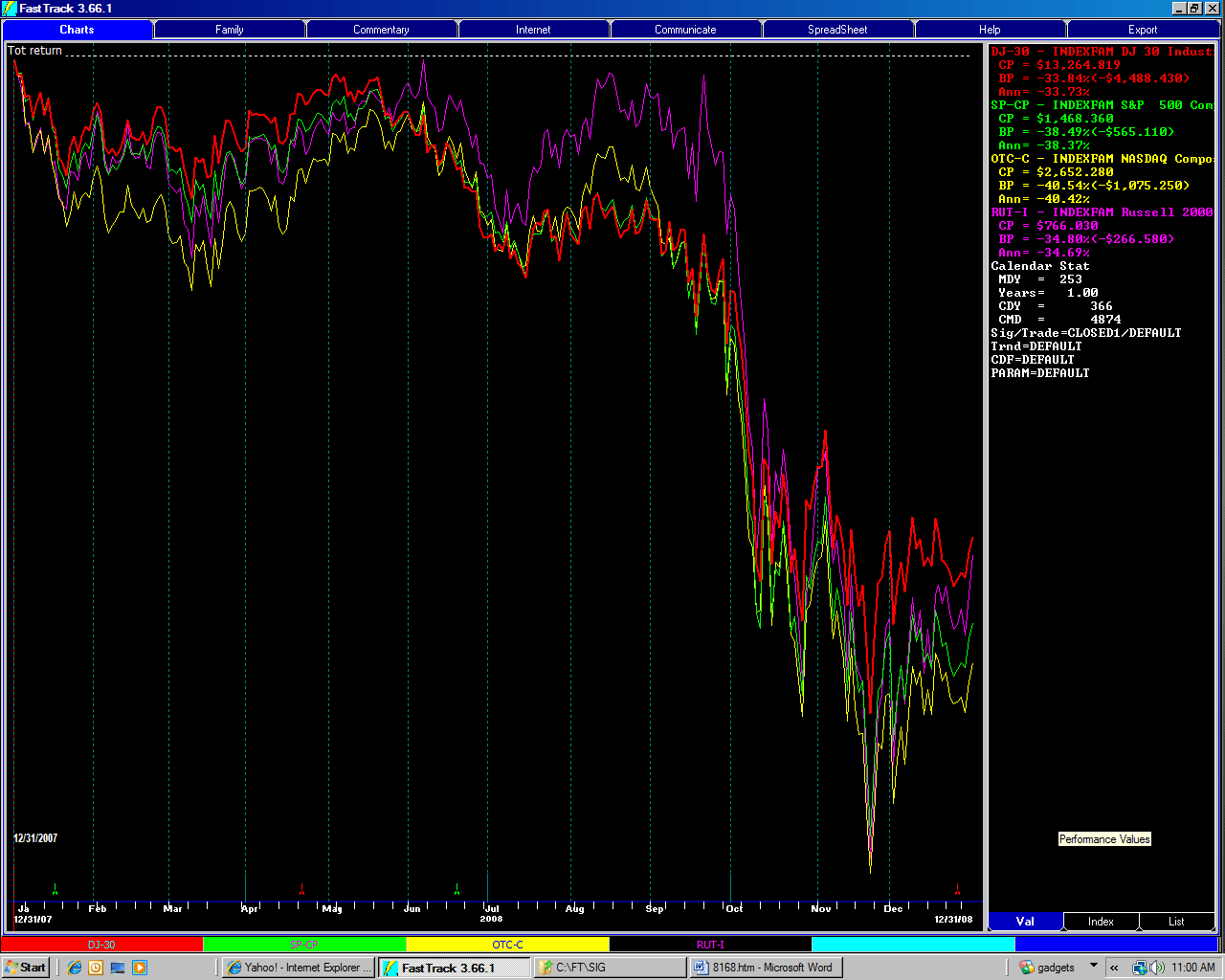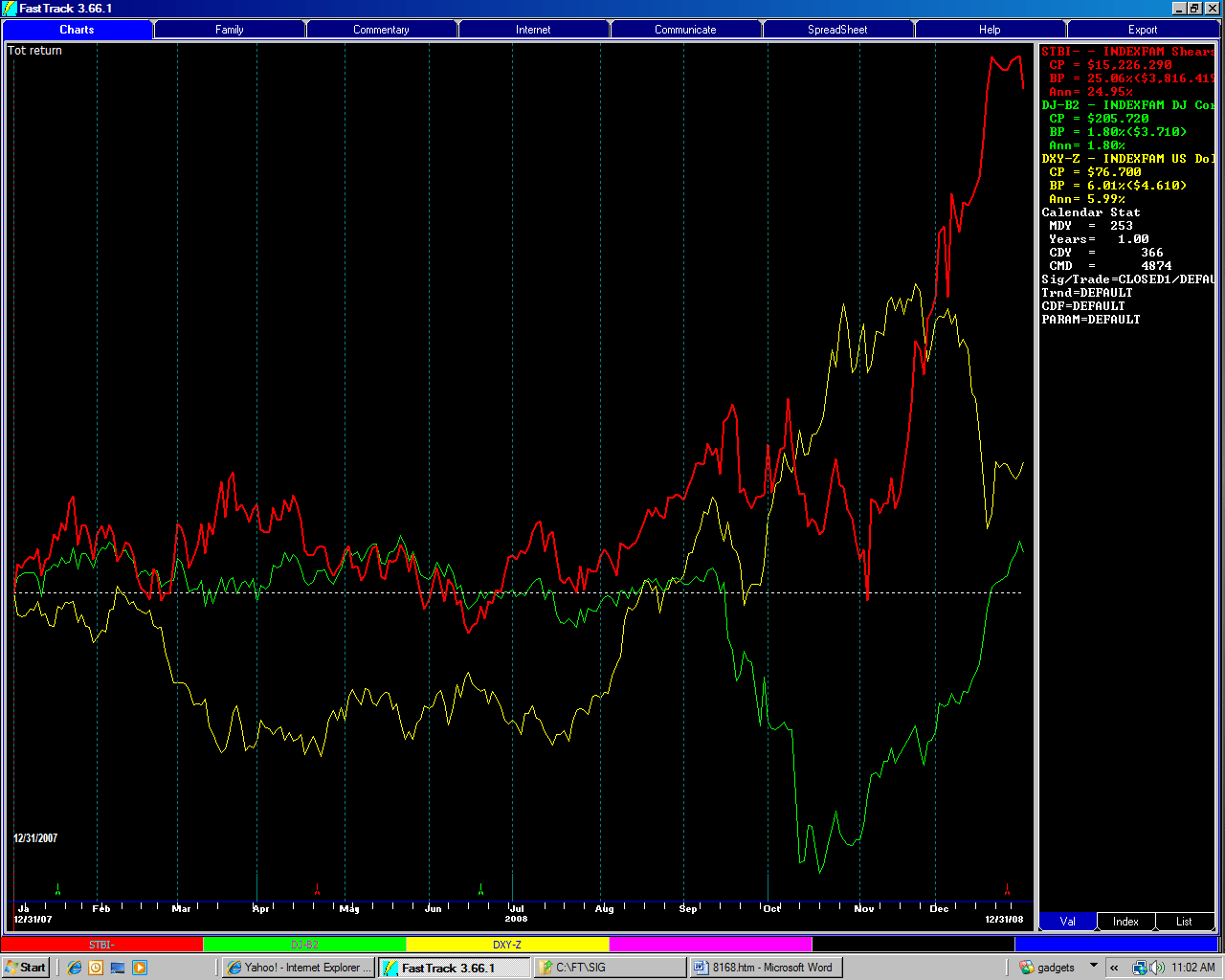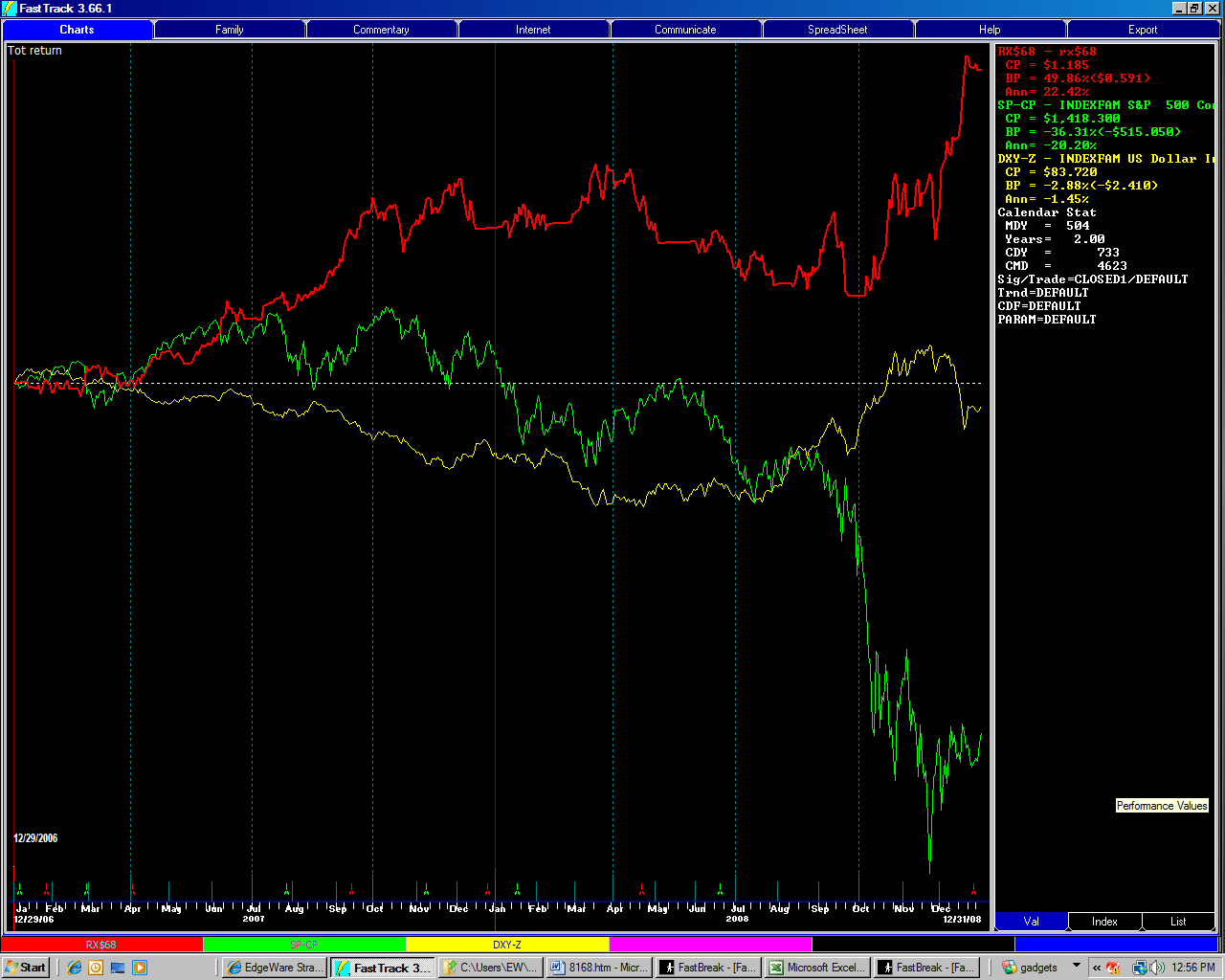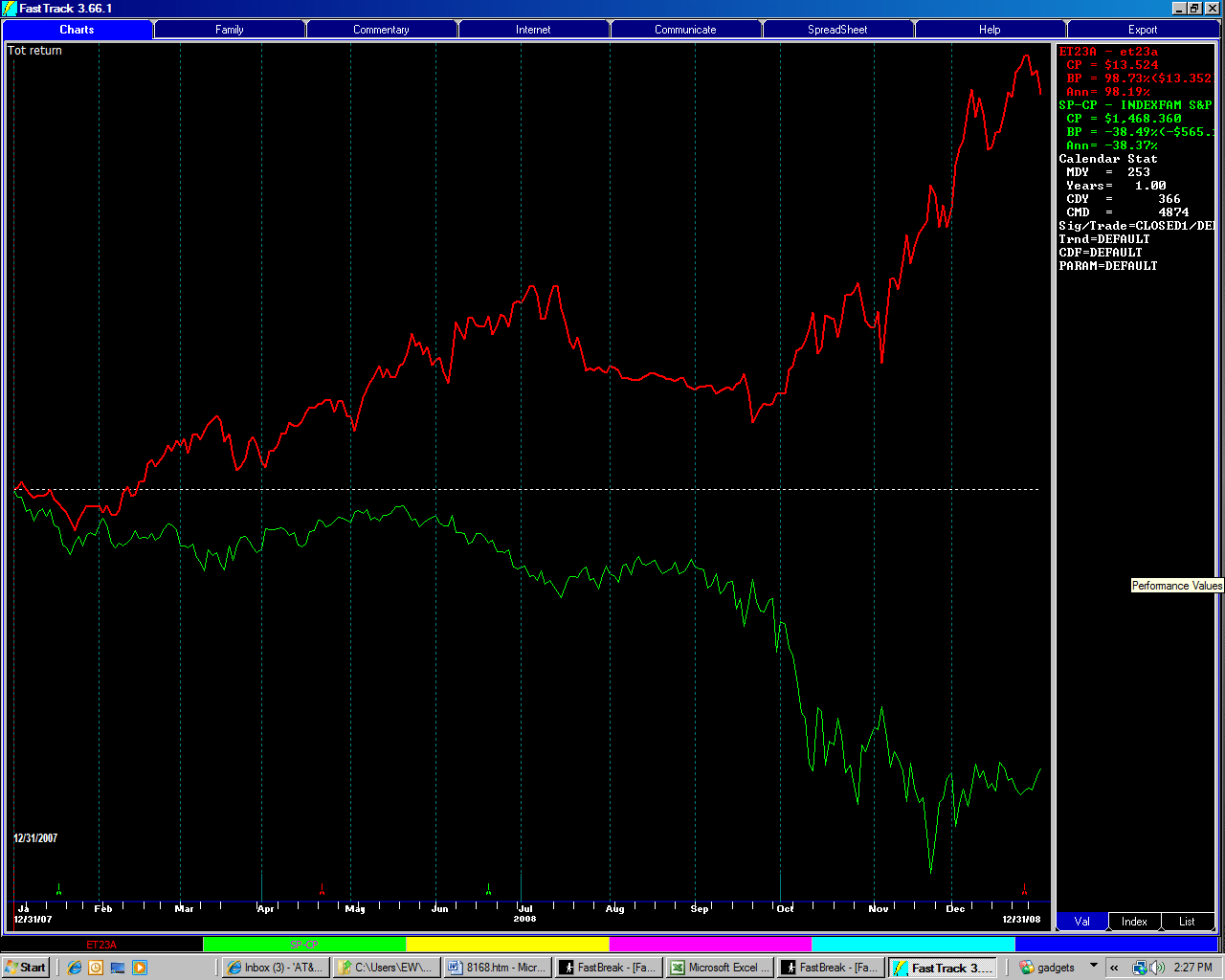02/22/2009 FastBreak - Year 2008 Review, Version 6 Release
Before reviewing FastBreak trading system performance for this past year we want to take care of several housekeeping issues.
Version 6 of Standard FastBreak and FastBreak Pro are now available
Version 6 (V6.2) is now the release version of both Standard FastBreak and FastBreak Pro. This new version contains the automated Trendline Stop Loss and Buy Filter that we described in last year’s commentary. The Trendline capability has proven useful in avoiding some pitfalls during the recent difficult market conditions. A detailed description of the trendline capability is available in the manual found on our website www.edge-ware.com The Pro version will optimize the trendline parameters and the Standard version allows users to try the trendline capability in a manual mode and allow running strategies that have been built using the Pro version optimizer.
FastBreak Pro V6.2 adds the useful option to suspend all Stop Loss options during optimization for an initial period after a fund is purchased. We added this feature for a couple of reasons. One, we have users who use fund families that absolutely prevent exiting a fund for a fixed number of days, e.g., 7 and 30 days are quite common. The second reason is that some companies will allow short term trades, but limit you on the number of short term trades. Fidelity for example, will only allow 15 short term (less than 30 days) trades during a 12 month period. If a user wants to build a system to either prevent or limit the number of short term trades this new feature will prevent any of the stops from being effective when building trading using the Genetic Algorithm optimizer.
Our policy is to support the two most recent release versions, i.e., V5 and V6; therefore we will no longer support earlier versions or be able to supply replacement installation CDs for earlier versions.
Ordering information and prices appear at the end of this commentary.
Free Upgrade
As a service to our customers who purchased Version 5 of Standard FastBreak or FastBreak Pro in 2008 and early 2009 (including upgrades) we will be mailing a FREE installation CD for V6.2 The past year was difficult for most investors and this is our way of saying “Thank you” for your business. We hope to send the disks out before the end of March. This installation will allow you to download any future updates to version 6.
New Demo Available
The Standard FastBreak 30 day demo on our website is now based on V6.2 This will allow potential users to try the Trendline option in a manual mode. There isn’t a demo for the Pro version
New Beta Versions for Version 5 users
Read this section carefully as it may be very confusing.
As a service to Version 5 users, we placed new beta versions of FastBreak Pro and Standard FastBreak on our website (www.edge-ware.com). There is no cost to download and try these beta versions, but they will only work for users who have Version 5. Users of earlier versions of FastBreak will not be able to run the betas. Users who have Standard V5 will be able to run the new Standard V6.1 beta. Users who have Pro V5 will be able to run the new Pro V6.1 beta.
We are calling these Beta V6.1 and they have EXACTLY the same functionality as the new V6.2 release.
These beta versions will not be upgraded or maintained. As we upgrade the official release version with future changes (V6.3, V6.4 etc.) we will not be updating the betas and only those who purchase V6 will be eligible for the updates.
Note: As stated earlier in this commentary, those who purchased version 5 beginning in 2008 will receive a FREE release version of 6.2 so there is no need to download the beta versions and you will be eligible for any future updates.
Contact and other information
Our contact email address is email2ew at edge-ware.com for all inquiries and tech support. Email spam continues to be an increasing problem and we recommend you put the word “FastBreak” in the title of your emails so our spam blockers don’t block your message.
For information on all our products and past commentaries see FastTrack Commentaries 8160, 8161, 8162, 8163, 8164, 8165, 8166, 8167 and visit www.edge-ware.com
2008 Year in Review
This commentary will review several different types of trading systems.
The first version of FastBreak was released in early 1996. Potential users of any investment software product should always ask the question "What is actual performance?" Soon after the initial release we developed trading systems that could be monitored for "real time" performance. We don't modify trading system parameters during the performance reporting period and report on the systems on a yearly basis. The 2004 - 2007 reviews are available in FastTrack Commentary 8164 - 8167. If you would like to review all reports since 1997 visit our web site www.edge-ware.com and go to the Strategies page.
We place example FastBreak Pro developed trading systems on the Strategy page of our web site. These systems provide users and potential users a starting point on the many different types of trading systems that can be built with FastBreak. It also allows us to provide an honest benchmark for real time performance. Users of both Standard and Pro versions can download these systems. The Standard FastBreak 30 day demo (Note: The current demo is based on Version 5, we plan to make it Version 6 later this year.) that can be downloaded from the web site can also run these strategies but will not display the last 60 market days of trades. Many of these systems are several years old. We can now build better trading systems, but we keep these systems on our web site to show that many trading systems are effective for long periods of time.
We don’t often post or change the strategies on our web site because we believe investors’ needs are very unique and users of our software should feel confident developing their own trading systems.
Most of strategies we report on are "out-of-sample/real time” for the entire year and in some cases the strategies have been unchanged for several years.
The

The bond market as measured by Treasuries (STBI-) and Commercial bonds (DJ-2B) was nearly a repeat of 2007. Early in the year there was no clear consensus on if the Federal Reserve would ease or tighten credit. Late in the year it was all about risk. Treasuries really took off as a safe haven when many corporate bonds and even money market funds became suspect. The high yield end of the market tanked as credit concerns spread. There isn’t a common High Yield bond index, but the FastTrack family of high Yield bonds were down approximately 20% on average. As is well known, as US interest rates declined the US dollar often becomes weak (See DXY-Z in the chart below) but this year there was the unusual flight to the “safety” of the US dollar even as interest rates plummeted.
Here is a summary of common benchmark performance in 2008:
|
Return % |
MDD |
UPI |
|
|
S&P 500 |
-38.5 |
-48.8 |
* |
|
DJ-30 |
-33.8 |
-43.1 |
* |
|
OTC (NDX 100) |
-41.9 |
-50.3 |
* |
|
STBI- (Treas. Bond Index) |
25.1 |
-8.5 |
8.6 |
|
DJ-B2 (DJ Bond Index) |
1.8 |
-13.9 |
1.1 |
|
High Yield Bonds (average) |
-20 |
N/A |
N/A |
|
DXY-Z (Dollar Index) |
6.0 |
-10.3 |
2.24 |
We include two measures of investment returns for professional managers:
|
|
Return% |
|
Managed Futures Funds |
Approximately: +10 to +12 % |
|
Hedge funds |
Approximately: -15 to -25 % |
The above values are approximate because of the difficulty obtaining reliable information on these programs. Hedge funds have had considerable investor interest during the past few years as an alternative investment, and there has been a tremendous flow of money into these funds. Managed futures and hedge funds typically charge 20-25% of gains for their investment services. These funds are usually only open to qualified investors (those with a net worth of $1M or more) and minimum investments of $500,000 or more is not uncommon. Many managed futures funds well again this year due to volatility in commodity prices. However, 2008 was the year of many Hedge fund train wrecks. It is difficult to obtain a good estimation of Hedge Fund performance because many funds that failed or had poor performance stopped reporting returns.
How did the FastBreak strategies posted on our web site perform? Note: the date in the table below indicates when the system was posted on our web site. In many cases the system was trading real time well before posting.
|
System Return% |
MDD |
UPI |
|
|
Bond system (2/18/2002) |
2.7 |
-9.2 |
1.1 |
|
International funds (6/10/2002) |
-7.8 |
-13.8 |
-0.44 |
|
Bonds LT Gov and HY (2/13/2003) |
3.6 |
-3.9 |
2.9 |
|
Bonds Conservative zero coupon (2/13/2003) |
12.8 |
-4.3 |
9.4 |
|
Bonds Aggressive zero coupon (2/13/2003) |
-1.8 |
-8.1 |
0.3 |
|
Short bond (Rydex) (2/13/2003) |
-5.6 |
-7.65 |
-0.4 |
|
Short NDX-X (Rydex) (3/10/2003) |
48.8 |
-16.7 |
8.7 |
|
Short S&P 500 (Rydex) (3/10/2003) |
14.6 |
-16.8 |
2.04 |
|
Income Strategy (10/14/2003) |
-18.8 |
-25.3 |
-1.12 |
|
Long/Shot Gov Bonds and US$ (new) |
22.6 |
-15.7 |
3.1 |
Bond systems were a mixed bag. The bad news is that the systems that contain Treasury funds in their trading family didn’t take advantage of the rapid rise in Treasuries late in the year. The Treasury market was extremely volatile before blasting upward during the panic. Compared to the industrial bond index the systems did well. Compared to High Yield bonds the systems were outstanding. For example, Fidelity’s excellent HY bond fund, FAGIX, was down over 30% with a MDD of nearly 40%.
The International system has been around since 2002 and has had stellar performance, but tripped slightly this year. Read previous yearly reports for background on this system. We have maintained reporting on this strategy to demonstrate long term strategy performance.
The Short Market sytems had a good year. We build these systems after the down market in 2001-2003. These systems could also be used to hedge long positions during market weakness. The system that shorts the S&P was a little disappointing but with strong bear market rallies it is difficult to maintain a short position. The system that shorts the NDX more than made up for it.
We have discontinued reporting on the growth systems that use the RUTTR and RUTVOL market timing signals. These excellent signals were very popular in the FastTrack community several years ago, but have since been overtaken by better signals.
The Income strategy had a somewhat disappointing year. This system has been around since 2003, and since being built, this system has returned nearly 30% compared to a loss of 14% for the S&P. This strategy trades Fidelity bond and real estate funds with few trades per year. We have reoptimized this system and put it on the website; however, it requires version 6 to execute because it utilizes a trendline Buy filter. We removed the Fidelity Real Estate Income fund from the trading family and substituted FSBIX for FBIDX.
The Long/Short - Dollar/ Gov Bond trading system. Last year we reported on a system that trades a family containing Rydex’s strong and weak US dollar funds, along with their long & short Government bond funds. This system was built with V6 FastBreak Pro and uses a trendline for a buy filter. The system has had nearly two full years of good real time performance and we have put it on our website (It requires Version 6 to execute). Here is a chart showing the two year performance of the system (Red) to the S&P 500 (green) and the US Dollar Index (yellow). The system has returned nearly 50% in the past two years. Obviously the system took advantage of the rapid rise in Treasuries late in 2008.
Other Mutual Fund Systems of Interest
Potential FastBreak users often ask about other systems such as Rydex and Fidelity Sectors. Here are some other systems we traded or monitored during the full year to provide additional information. The trading files for these systems are not posted on our web site.
|
System |
Return% |
MDD% |
UPI |
|
Annuity (4 funds no signal) |
0.5 |
-9.9 |
0.64 |
|
Rydex w/FastBreak signal |
-9.8 |
-17.3 |
-0.7 |
|
Rydex no signal |
-8.9 |
-18.2 |
-0.6 |
|
Select no signal |
-17.6 |
-18.4 |
-1.0 |
|
ProFunds (T17db signal) |
2.8 |
0 |
* |
The annuity system holds four positions in a trading family of 45 funds. The trading family includes a very diverse group of funds including international and bond funds. This strategy is reoptimized nearly every year due to annuity company changing many of their funds. One of the advantages of FastBreak Pro is the ability to quickly rebuild trading systems when there is significant change in investment program such as annuity or retirement programs. The system spent most of the year in money market or bond funds. We were quite happy with the performance.
Rydex and Fidelity sector system performance was OK. They generally stayed out of serious trouble. The ProFunds system was described last year. It uses a market timing signal that was out of the entire year and the system was in money market.
ETF Trading Systems
Last year we wrote that we ventured into ETF trading systems. ETFs are fantastic investment vehicles; unfortunately, there isn’t a lot of historical data for testing and system optimization. Some investors have successfully developed systems using other sector funds or indexes that have a long history and then substituting the ETFs into the system.
We took a couple of approaches on developing trading systems. One approach was simply to including all the ETFs in the FastTrack database and optimized over a period of time shorter than we generally like. We didn’t include any market timing signals because there are a variety of ETFs that go short and we wanted to try and take advantage of these. We also built systems that were more complicate: Two other systems used filtered versions of the FastTrack ETF family where we removed from 50% to 75% of the ETFs that were very similar to other ETFs. The intent was to force diversification. The system with only a 50% filtering of the ETF family was then further forced to diversity by holding uncorrelated ETFs. Another strategy combined two low correlation strategies. All system holds five ETFs.
We will not bore you will all the statistics but the systems had the following returns: -26%, -9%, +44%, and +98%. The two worse performing systems were based on the filtered families. The 44% system is the one that combined two low correlation systems. Finally, the best system was the least complicated system. This system simply tried to hold the best performing ETFs. Here is how your year would have looked trading this system:
You would have started the year generally in commodity related ETFs, and then finished out the year in short commodity and short stock ETFs.
This ETF system follows long term trends so it can be painful when major trends reverse and new trends are still being established. However, the MDD was a respectable 21%. This system has a historical return of approximately 25% since January 2, 2001 so you can see it exceeded even the optimized period – which is not very common and shouldn’t be expected to happen again anytime soon! It will be interesting to see how these systems respond as we go into 2009.
Stock Trading Systems
Review the 2005, 2006 and 2007 commentaries that described stock trading systems built using FastBreak Pro. Trading individual stocks can produce spectacular returns or equally impressive failure.
Stock trading systems we have built in past years were all over the board. Approximately half the systems, including all the small cap value stock systems, spent the entire year in cash because of the market timing signal used. Several of the other systems did go to cash during the market sell off and had only moderate losses for the year. Overall, there were no outstanding results. It certainly wasn’t a year to be in individual stocks.
Summary
In a very difficult year FastBreak performance was acceptable. Most of the systems stayed out of significant trouble, but yes, there were losses and drawdowns larger than we like; however, a 10% loss only requires an 11% gain, and even a 20% loss requires only a 25% gain, to get back to even. Many buy and hold investors are looking at 100% gains or more, just to get back to where they started the year. The one message that we keep emphasizing is that investors should diversify across multiple trading systems and asset classes. No one system is going to trade well in all markets.
What is FastBreak and Who needs FastBreak
Unlike other trading methods, the FastBreak "mechanical" trading strategies gives specific buy and sell recommendations. Mechanical trading systems leave no room for historic "revision". These types of trading systems may not be for everyone, but we believe they should be considered if you recognize yourself in the following:
- Do you have trouble "pulling the trigger" on trades, e.g., selling your losers, taking profits on your winners, waiting for a bounce to get out of a bad trade ...?
- Do you have a limited amount of time to devote to your investments? If you are a full time investor, or enjoy sitting in front of CNBC and your computer all day, you may be able to do better with other investment methods. However, if you have limited time (or better things to do with your time!) a few minutes an evening is all you need to download your FastTrack data and run your FastBreak strategies.
- We have stopped reporting on some of the older FastBreak systems for a variety of reasons: Many of the mutual funds used in these old trading system families have since been discontinued, the market timing signals (unrelated to FastBreak) used did not stand the test of time, and we can build much more effective strategies with the functionality added to FastBreak in recent years. We felt that those systems don't accurately reflect the performance that FastBreak can produce.
Edge Ware, LLC.
Standard Disclaimer
As the saying goes, "Past performance is not a guarantee of future results."
If you have additional questions we can be contacted at email2ew@edge-ware.com DO NOT CALL INVESTORS FASTTRACK for information!!


